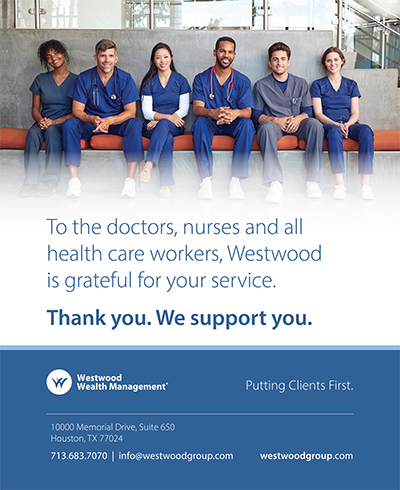
By Ketan Patel, Advisory Principal, KPMG Healthcare
Barring a rebound surge in COVID-19 cases, healthcare providers have stalled elective – and not so elective surgeries – to control the spread of coronavirus in March and April. This has strained finances at many healthcare providers to a point where they are borrowing, drawing from foundation funds or other sources of cash to continue.
The COVID-19 peak was expected in Harris County the week of April 19. More than 5,827 cases and 98 deaths were reported. Hospitals developed offsite locations in preparation for the surge, but many health systems were left with empty beds and lower revenues.

While nobody can predict for certain whether cases will rebound in the coming months, healthcare executives need to address funding, replacing volume and broadly reducing costs to help with the recovery post-COVID19.
Funding
In addition to borrowing or using foundation funds, the Coronavirus Aid, Relief and Economic Stimulus (CARES) Act and a successive funding law provide as much as $175 billion in funding for healthcare providers related to expenses and lost revenue tied to COVID-19. The CARES Act also extended funding several programs and delayed a Medicaid disproportionate share hospital reduction until December 1.
Medicare and some payers have also set up accelerated advanced payment programs to support cash flow needs of healthcare providers. Most providers can get advances of 100 percent of Medicare funding for three months. Inpatient acute care, children’s and cancer centers can get 100 percent advances from Medicare for six months, while critical access hospitals can get up to 125 percent for six months. The accelerated payments need to be made with a Medicare Administrative Contractor and are eligible for providers that have billed Medicare within 180 days and are not bankrupt, under investigator or have delinquent payments.
For Houston’s healthcare providers that have been through Hurricane Harvey and other natural disasters, seeking FEMA funding should be part of the routine. The funds cover 75 percent reimbursement for costs incurred such as an emergency operation center, temporary medical facilities, waste disposal, specialized equipment and non-deferrable treatment and other costs. That is coordinated through local emergency management officials or FEMA regional offices.
Addressing Volume
With many elective and non-COVID procedures being deferred, there is a backlog of procedures across a variety of medical specialties. That pent up demand poses a challenge and an opportunity to create greater patient trust and foster better engagement.

For some healthcare organizations, it can take as long as 19 weeks to reschedule the loss of one week of activity. Patients may get impatient with delays that long and seek care elsewhere.
Enhancing patient access programs, telehealth, and other programs can be applied to improve patient engagement and build patient loyalty with all the information gathered to understand patient preferences and their specific issues beyond their conditions. This sort of knowledge about the patient is a competitive advantage for providers and one that should not be frittered away. As we emerge from COVID-19, it makes sense to reach out to those people who have had care deferred to reschedule appointments and extend hours to cut that 19-week window.
Before manning the phones and e-mail lines to reach patients, healthcare providers need to reassure patients that the highest infection control standards are in place, especially since claiming victory at this stage of the pandemic may be premature.
Reducing costs
Patient access programs have a part in reducing some costs, since they are digital platforms that help connect patients to the health system. Beyond that, health systems need to look at broader levers to manage costs.
Corporate support functions, such as finance, accounting, HR, compliance, IT and other roles, are normally the most logical places to look for costs to be cut. Many of these roles in the past few decades have been targeted by outsourcing and other efficiency drives, leaving little opportunity to cut costs by traditional means. Some of these roles need to be rethought about where artificial intelligence, robotic process automation and other technologies can be applied to improve efficiency.
Based on changes in how the support will be delivered, real estate can be examined for reducing costs. With a significant portion of the workforce now telecommuting, healthcare executives need to consider rationalizing building use. A thorough examination of leases, properties owned and how they are used makes good sense and could uncover savings in property taxes, rent, and utilities, while also finding opportunities for more productive uses of space.
With different care delivery models, clinical labor needs to be examined to handle more telehealth or adjust to a new COVID-19 environment and how providers operate in the future. Cutting clinical jobs could backfire, especially in the short term. Texas already has a well-chronicled nursing shortage and the best approach may be to redeploy nurses across departments by need with the help of scheduling programs, which can use artificial intelligence to help forecast demand.

Also, healthcare providers need to examine their supply chains about inventory and their group purchasing organization arrangements, since the coronavirus exposed frailties in the ability to get N95 masks and other protective gear. While there may be opportunities to reduce costs and working capital needs tied to inventory, alternative sources of supplies should be developed as part of contingency planning. Beyond the shortages of PPE, healthcare purchasing executives need to review pharmacy costs, physician preferences for medical/surgical devices and other opportunities to create efficiency.
Conclusion
COVID-19 is posing many challenges for Houston’s healthcare community and may represent the most complex issue that most clinicians will see in their careers. The loss of life and illness connected with COVID-19 is tragic. However, the precautions urged by public health officials and the medical community are mitigating the risks to the public. As state officials plan to ease some of the social distancing efforts to control COVID-19, the healthcare community must remain vigilant about infection control and screening patients to prevent new cases from spiking. Healthcare providers, however, have to adapt to ensure their own financial viability to ensure they are part of the post-COVID-19 recovery. An organization’s ability to pull different cost and revenue levers to weather the storm will enable it to thrive post-coronavirus and continue to serve its mission and community.


